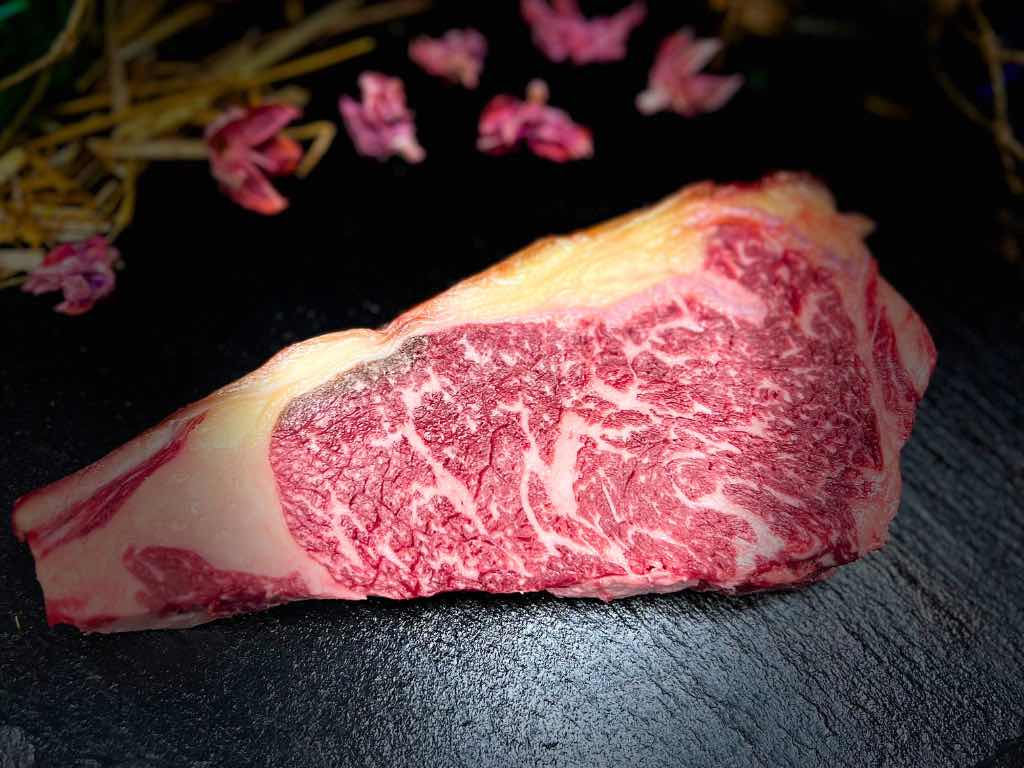
Savoring Dry Aged NY Strip: Culinary Mastery Unveiled
|
|
Time to read 5 min
Welcome to One Stop Halal!
Written by: Samir P.
|
|
Time to read 5 min
In the realm of steak lovers, a culinary gem elevates the dining experience to unparalleled heights – the dry aged New York strip steak. Renowned for its intense flavor, tender texture, and sublime marbling, this masterpiece of meat represents the pinnacle of steak perfection. Join me on a savory journey as we delve into the fascinating world of dry aged NY strip steak.
Dry aging is an ancient technique that dates back to a time before modern refrigeration. In an era when preserving meat was necessary, our ancestors discovered that allowing beef to age in a controlled environment resulted in remarkable changes in flavor and tenderness. Initially, this process involved hanging beef in cool, dry places to naturally tenderize and concentrate its flavor. Over time, this practice evolved into the sophisticated art of dry aging.
Dry-aging beef is a fascinating process combining science and art to produce the rich, complex flavors and tender texture that steak enthusiasts crave. At its core, dry aging involves controlled decomposition, enzymatic action, and moisture loss, all of which contribute to transforming ordinary beef into an extraordinary culinary delight.
One of the key factors in dry aging is enzymatic breakdown. Naturally occurring enzymes within the meat, such as cathepsins and calpains, begin to break down the tough connective tissues and proteins in the muscle fibers. This enzymatic activity gradually tenderizes the meat, resulting in a more succulent and melt-in-your-mouth texture. Additionally, as these proteins break down, they release amino acids and peptides, which contribute to the development of complex, savory flavors.
Another crucial aspect of dry-aging is moisture loss. As the beef ages in a controlled environment, such as a refrigerated room or cabinet, moisture evaporates from the meat. This loss of moisture concentrates the flavor of the beef, intensifying its natural beefiness and creating a more robust taste. Additionally, as the moisture evaporates, the outer layer of the meat forms a dry crust known as the pellicle. This crust helps seal the meat's juices during cooking and adds an extra layer of flavor and texture to the finished steak.
While often overlooked, microbial action also plays a role in the dry-aging process. During aging, beneficial bacteria and molds in the air interact with the surface of the meat, further enhancing its flavor and texture. These microorganisms help to break down proteins and fats, contributing to the tenderization and maturation of the beef. Additionally, certain molds produce enzymes that can impart unique flavors to the meat, such as nutty or earthy notes, further adding to the complexity of the final product.
Proper temperature and humidity control are essential for successful dry-aging. Typically, beef is aged in a carefully controlled environment where the temperature is kept between 34°F and 38°F (1°C to 3°C), and the humidity is maintained around 80% to 85%. These conditions help to slow the growth of harmful bacteria while allowing beneficial enzymes and molds to flourish. Additionally, consistent airflow is essential to ensure that the meat ages evenly and develops a uniform flavor and texture throughout.
In conclusion, the science behind dry aging is a delicate interplay of enzymatic breakdown, moisture loss, microbial action, and environmental control. By harnessing these factors, butchers and chefs can transform ordinary beef into extraordinary dry-aged steaks that captivate the senses and elevate the dining experience to new heights.
Dry aging is as much an art form as it is a science. Achieving the perfect dry-aged NY strip requires skill, patience, and meticulous attention to detail. Here are the critical steps involved in the process:
The journey to exceptional dry-aged steak begins with choosing the finest quality beef. Prime-grade beef, known for its superior marbling and tenderness, is preferred for dry aging. With its ideal balance of lean meat and rich marbling, the NY strip is particularly well-suited to this process.
Creating the perfect environment for dry aging is essential. Temperature, humidity, and air circulation must be carefully controlled to ensure optimal results. Typically, beef is aged in specialized refrigeration units where temperature and humidity levels are closely monitored and adjusted.
Dry-aging is not a process that can be rushed. Depending on desired flavor intensity, steaks may be aged for anywhere from two to six weeks or more. During this time, the beef undergoes gradual transformation, developing its signature flavor and tenderness.
Once the aging process is complete, the outer layer of the beef, known as the pellicle, is trimmed away to reveal the beautifully marbled meat beneath. The steak is then expertly cut and prepared for cooking, ensuring every bite is a masterpiece of flavor and texture.
Welcome to Home of the Halal Wagyu. We carry various Wagyu meat cuts that are hard to find elsewhere. We deliver to your doorstep anywhere in the United States within 1-2 business days.
In a world where fast food and convenience often take precedence, the art of dry aged NY strip steak is a testament to slow food's timeless allure and traditional craftsmanship. From its humble origins to its status as a gourmet delicacy, the journey of dry-aged beef is a story of passion, dedication, and reverence for the culinary arts. So, the next time you crave a genuinely exceptional steak experience, treat yourself to the unparalleled delight of a dry aged NY strip – a culinary masterpiece centuries in the making.

© 2025 One Stop Halal, Inc.